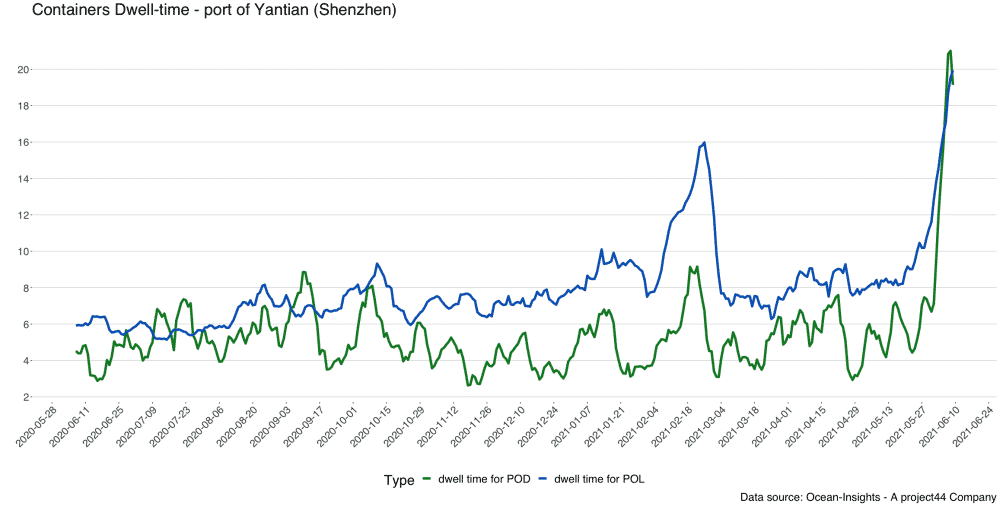
[ad_1]

Vessel delays at the Yantian Port, a deepwater port in Shenzhen, has been worsening over the last week and the port is expected to remain congested throughout the month, based on project44’s container dwell time data. The congestion at Yantian is due to tight controls over a detected COVID-19 outbreak on May 25, 2021, amongst port workers, resulting in container liners sending out client advisories on blank sailings.

Image Credits: WGigel.atat / wikimedia.org
By June 7, project44 found that minimum dwell times at YICT as a port of loading was one day, while median dwell times were at most 18 days. While minimum dwell times at YICT as the port of discharge was also a day, median dwell times were far higher at 18 days. The Yantian Port kept its container yard open to vessels from May 31 to June 6 and the Shekou Port (another port facility in Shenzhen) is accepting vessels within an ETA of five days from June 1.
The COVID-19 outbreak continues to spread as authorities in Guangzhou, the industrial city northwest of Shenzhen, have also imposed restrictions on business activity. The Nansha Port, one of the fastest-growing terminals from Guangzhou, will also feel the impact of these restrictions, further increasing congestion issues in Yantian.

Image Credits: project44
Port congestion in the South China Sea surrounding Yantian has been severe. As of June 7, 47 vessels are approaching the port with upcoming ETAs of which 22 vessels with ETAs already in the past. With roughly 32% of all vessels approaching Yantian delayed already, the congestion is expected to exacerbate over the next few weeks. Several container lines have announced rerouting their vessels away from the Shenzhen port cluster to preserve their schedule reliability.
“The recent rise in COVID-19 cases in China has resulted in a shutdown that may add to the already record cost of shipping goods out of China. The delays have already resulted in pressurizing soaring shipping prices within China due to a lack of containers and increased export demand. These high shipping costs are just one factor that may contribute to an additional looming threat to global inflation,” said Josh Brazil, the vice president of marketing at project44.
Interruptions caused by the COVID-19 outbreak have reduced container supply further, even as demand for Chinese goods remains at record highs. In the last year, freight costs between China and the US West Coast have gone up by 156%, while China to the US East Coast trade lane saw an increase of 162%. Freight prices between China and North Europe gained the most, witnessing a 535% increase. These elevated prices reflect the costs incurred with high demand, reduced capacity, and increased dwell time across the Chinese coast.
The obstruction will mean additional blank sailings in June from Yantian to Hong Kong to the US West Coast. Container capacity may reduce by roughly 50% from the port, and there could be restrictions on the carriers allowed to release premium shipping containers. For Asia-Europe trade lanes, carriers have announced blank sails from northern ports like Tianjin and Quindao, citing congestion issues.
Importers from the US and Europe must remain wary of the overall deterioration of maritime trade lanes originating from China and plan their freight operations accordingly.
Press Release
[ad_2]
This article has been posted as is from Source